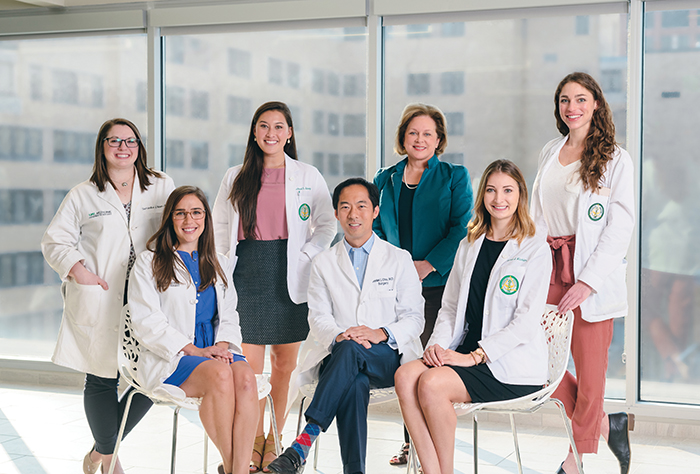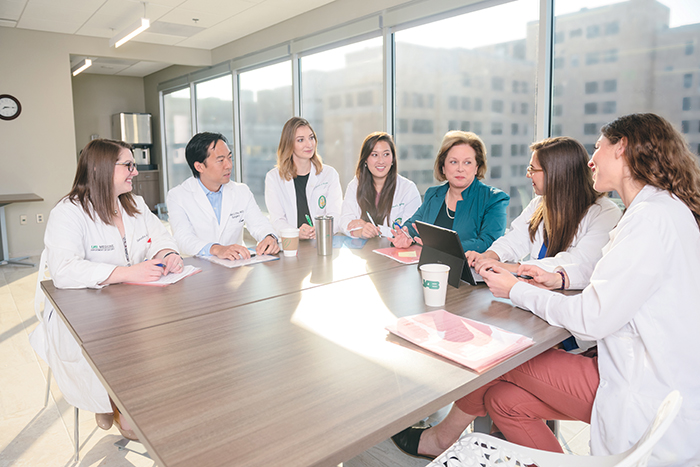 Low health literacy is all too common in a large portion of the nation’s population. UAB health care teams and medical trainees are working to fix that.
Low health literacy is all too common in a large portion of the nation’s population. UAB health care teams and medical trainees are working to fix that.
While researching health literacy in the surgical population, Associate Professor Daniel Chu, M.D., of the Division of Gastrointestinal Surgery, and his team found that low health literacy is quite prevalent and exists across every socioeconomic class, race, and geographic origin. However, certain groups are at higher risk for having low health literacy, and this information will help develop more targeted interventions.
“African-Americans with inflammatory bowel disease, for example, in Alabama and Mississippi have high rates of low health literacy and face incredible challenges dealing with a complicated disease that requires complicated management,” Chu says. “As providers and health care systems, we are responsible for helping these patients achieve the best possible outcomes and experiences. Health literacy is one way to take immediate action, and we are learning that the most impactful interventions occur at the provider and health care system level.”
Chu, who also serves as associate director of Health Services Research, notes that research has consistently linked health literacy with health outcomes. To be specific, patients with low health literacy are at high risk of having poor health outcomes and experiences. But this relationship is potentially modifiable in a positive direction.
“It is quite important to invest time and resources in addressing low health literacy because, if we can improve health outcomes and experiences, we benefit patients, providers, and health care systems,” Chu says.
 Surgery residents Samantha Baker and Lauren Theiss, medical student Rachael Rainey, Daniel Chu, Joy Deupree, and medical students Kara Kichler and Elle Kaplan comprise some of the team studying health literacy. Why We’re Here
Surgery residents Samantha Baker and Lauren Theiss, medical student Rachael Rainey, Daniel Chu, Joy Deupree, and medical students Kara Kichler and Elle Kaplan comprise some of the team studying health literacy. Why We’re Here
To help understand why there is such a low health literacy rate, Chu asked UAB School of Medicine students and residents to survey patients on their understanding of patient education materials that were provided to them.
Elle Kaplan, a third-year medical student, was asked to study the readability of documents and how the layout of documents affects readability. She says one of the things that shocked her most was that a higher education level did not necessarily translate into higher health literacy.
“If people don’t have the capacity to understand, they won’t adhere to guidelines set for them,” Kaplan says. “As medical professionals, we can’t assume everyone knows what we’re talking about. This research has opened a Pandora’s box in many ways. Just because you are fluent in business or English doesn’t mean you have a high level of health literacy.”
Kaplan says more image-based information—like infographics—were more widely understood compared to a page filled with words and bullet points. The old adage “a picture is worth a thousand words” absolutely holds true, according to Chu.
Samantha Baker, a third-year surgery resident at UAB, helped develop patient education materials for patients at the Birmingham VA Medical Center. She says her previous training in medical school prepared her to work with patients in Birmingham who had a similar level of health literacy.
“When I meet with patients, I say to them, ‘I know, when you leave here, you will want to tell your family members what we’ve talked about, so why don’t we practice? Tell me what you are going to say to them about our visit,’” Baker says. “I ask this so that I can know if we are on the same page and I can identify any gaps in their understanding.”
 Recruiting Collaborators
Recruiting Collaborators
Chu also enlisted help from UAB School of Nursing Associate Professor Joy Deupree, Ph.D. Deupree, who serves as chair for the Alabama Health Literacy Initiative, has poured countless hours into understanding why states like Alabama have such poor health literacy rates.
In 2016, an executive order signed by former Alabama Gov. Robert Bentley created the Health Literacy Partnership of Alabama; the work of the partnership concluded in February 2017 and produced a strategic plan to begin efforts to improve health literacy in the state.
Deupree says patient anxiety can be a major contribution to low guideline adherence. “What happens when you get in a car accident? You have so much running through your head that it is hard to think,” she says. “The same thing happens when you get a dire diagnosis—your head can get so cloudy that you have a hard time making clear decisions.”
She adds that there is a misconception about the face of health literacy. Many providers are adept at recognizing populations expected to be at risk to misunderstand health information—such as high school dropouts, lower socioeconomic populations, and those with English as a second language.
“In reality, the largest demographic group in the U.S. at risk for low health literacy is our seniors. They have been out of school the longest and grew up at a time when medicine was much less complex,” she says.
With Deupree’s help, Chu and his team are hoping to make things easier for patients by simplifying information in easy-to-read formats.
“Our research with patients and focus groups has reiterated this and suggests that more visually based information could help patients better understand the surgical journey,” Chu says. “I think surgery is particularly amenable for this as we are a very visually based field.”
He adds that the goal of his current research is to convert text-heavy patient education material into image-heavy media using best practices in design and technology. He says he thinks image-based media will lead to a better understanding of complex surgical information and, ultimately, beneficial effects on patient outcomes and experiences.
By Adam Pope